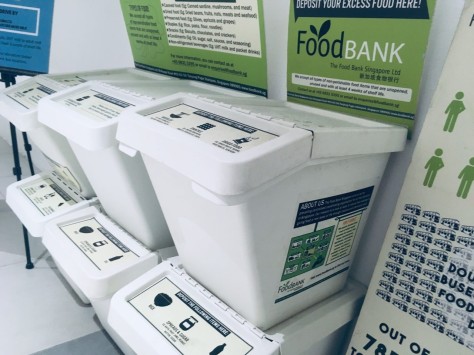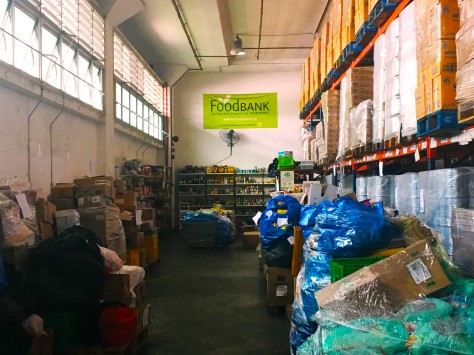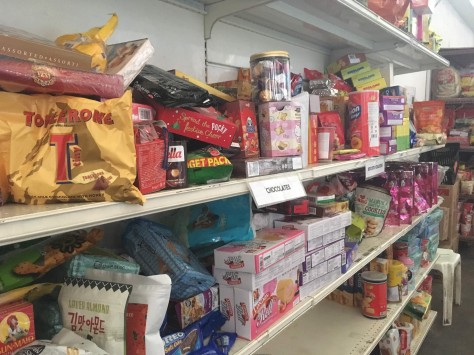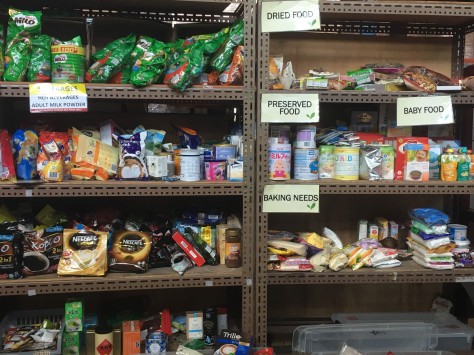You might have noticed these sleek white boxes popping up around your town recently:

If you’ve ever been curious enough to peruse their charming infographics, you’ll know that they’re collecting non-perishable food items from the general public, so that they can be delivered to the food insecure population in Singapore, rather than collect dust on mistake-prone shoppers (it happens to the best of us ;)).
I, too, was curious… Curious enough to travel all the way down to their warehouse on Keppel Road, which serves as the headquarters for this simple, spirit-lifting operation!



That’s it! This is where the food you drop off in their boxes is stored, sorted, and carted off to over 300 beneficiaries ranging from family service centres, nursing homes and childcare centres. An office the size of a regular school classroom and a storage space the size of a regular school hallway are where a tiny organization brings their big ambition to life – and the issue at hand is certainly huge. FoodBank Ltd was born when sibling entrepreneurs Nichol and Nicholas Ng discovered the magnitude of Singapore’s food waste problem.
As a land-scarce nation, Singapore has only one landfill for waste disposal – Semakau Landfill, which does not accept organic waste (Tan & Khoo, 2006). Thus, food waste is largely incinerated, generating huge quantities of carbon emissions. In 2002, for example, Singapore produced almost 500,000 tons of food waste, 94% of which was incinerated (Lang, 2008). In 2004, slightly over 300,000 kg of carbon monoxide and carbon dioxide emissions were generated per ton of food waste (Tan & Khoo, 2006). The implications of this overwhelming excess on Singapore’s overall carbon footprint are obvious.
Meanwhile, 12-14% of Singaporeans are living under the unofficial poverty line of $1500 in income per month (Loh, 2011), and by extension experience food insecurity.
FoodBank aims to close the gap between these two issues, eradicating their ironic coexistence in a fast-paced, extravagant Singapore. Though we’ve seen the quaint little warehouse where excess goodies from the wealthier spectrum of our society are stored, the real genius in this operation is that it largely takes place on the go. FoodBank knows that powdered Milo, biscuits and candy are far from enough, so in addition to facilitating the donation of non-perishables, its programmes include:
- A fresh food truck that collects fruits and vegetables rejected from supermarkets and wholesalers for solely cosmetic reasons,
- The Food Rescue Project, which whisks away excess cooked meals from the kitchens of reputable hotels and restaurants, and
- Joy in Every Bundle – bundle pledges for members of the public to fund balanced food packages for beneficiaries.
When you think about it, our food is needlessly thrown away through countless pathways, often even before they get the chance to reach our plates. For example, at Pasir Panjang Wholesale Centre, inspectors who need to work quickly will examine fruits and vegetables by the carton, and if they spy even one blemished item, the entire carton is discarded. That adds up. Three times a month, FoodBank’s van dutifully pulls up to the centre, fills to the brim with these fruits and vegetables, and distributes it to rental flats around Singapore. It’s hard not to think of what the situation looked like before FoodBank came along: all these riches, turned to rubbish, and on the same island where thousands of poor are living.
With that in mind, I asked an employee what she thought the organization could really use right now, and the answer is: long-term volunteers. Sorting and organizing the food items requires some training, and having nothing but ad-hoc volunteers means that the staff spends a lot of time teaching new volunteers, only to have them leave in a week. Consistent volunteers would save some of that time, and be able to train up newer ones as well.
If you are interested, do drop by their website and check out how you can get involved:
One more thing: this is going to seem trivial, but if you have a lot of used cardboard boxes around, well, the ones that they have at the warehouse are getting a little worn out. And of course, check out their website to participate in their various programmes, learn more about the food waste issue, and make a donation to help out with transport costs (you may have noticed that there is a great deal of transport involved). Wastage in general is awful, but food waste is downright painful. There’s a hole in our system, and it’s time to plug it.
Written by: Qiu Jiahui
References:
Lang, J. C. (2008) Zero Landfill, Zero Waste: The Greening of Industry in Singapore In Leapfrogging Development In Emerging Asia: Caught Between Greening and Pollution. pp 151-172. New York, New York: Nova Science Publishers, Inc.
Loh, J. (2011) Bottom Fifth in Singapore. Social Space. 88-90. Retrieved from https://ink.library.smu.edu.sg/cgi/viewcontent.cgi?article=1072&context=lien_research
Tan, R. B.H. & Khoo, H. H. (2006) Impact Assessment of Waste Management Options in Singapore. Journal of the Air & Waste Management Association, 56:3, 244-254, DOI: 10.1080/10473289.2006.10464463
